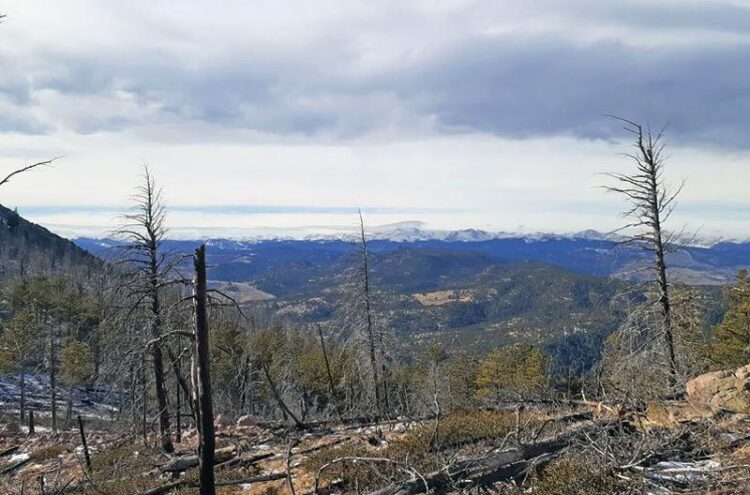Wildfire danger to increase due to climate change

Charred trees following a wildfire in Colorado (United States).
(c) Manuela Brunner
WSL Institute for Snow and Avalanche Research (SLF) researchers expect an elevated wildfire danger in the Alpine Foreland from 2040 onwards due to changing meteorological conditions. The danger currently remains very low in that region, but there is likely to be a shift in this regard as a result of climate change.
There is likely to be a significant increase in the danger of wildfires through the 21st century. Indeed, the expectation is that by 2100 the danger will be high even in regions where it is very low today. Those are the findings of a study by Julia Miller, a PhD student in the SLF’s Hydrology & Climate Impacts in Mountain Regions research group.
Forecasts show that the potential danger will continue to increase, but from 2040 onwards it will exceed the natural range of climate fluctuations and so will be attributed to climate change from then on. Taking the example of the Bavarian Alpine Foreland, this means that the meteorological wildfire danger will rise more rapidly from 2040 onwards, developing from low at present to high by the end of the 21st century. A weather-related event that currently occurs only once every 60 years will happen on average every 10 years by 2090. The projections also show that favourable weather conditions for wildfires will occur earlier in the year than today, i.e. in or around May. Currently, the wildfire season often begins in June. Vegetation that is already dry also means that fires can start more easily and get out of control more quickly. “Therefore, even regions with a temperate climate will need to prepare for wildfires in the future,” says Julia Miller. Such preparations range from water reservoirs for fire-fighting helicopters to warning signs alerting local people to the danger.
“The number of days when the wildfire danger is at least ‘high’ will more than double by the end of the 21st century,” predicts Miller. This trend is reinforced by factors such as hot, dry and windy weather. Summer heatwaves and drought events also reduce soil moisture, increasing the flammability of the vegetation. Miller is here addressing an issue that the Intergovernmental Panel on Climate Change (IPCC) raised in a 2021 report.
For her study, Miller used a number of climate variables and took natural and climate-related fluctuations into account. She made her forecasts based on the Canadian Forest Fire Weather Index (FWI). Underpinned by meteorological data, the FWI is a numerical rating of how readily combustible material (e.g. trees, dead wood, dry leaves) ignites and how rapidly a fire can develop. While the Mediterranean region and Western Canada have historically been prone to fire and have been extensively studied at a broader regional level, scientists have so far paid less attention to wildfires in the temperate regions of Europe. For her research, Miller used weather data from ‘hydrological Bavaria’ (the river catchments of the Danube, Main and Elbe), which she divided into four geographical and climatic subregions.
Given that the FWI does not take the vegetation situation into account, in her next study Miller would like to identify the role played by soil moisture and vegetation dryness in wildfire danger. She also analyses the climatic conditions under which the danger is greatest and highlights the regional differences within Europe. “Our aim is to show that wildfires in Europe can have different drivers. To this end, we would like to identify regional and seasonal differences in order to better understand the climatic factors that lead to large and uncontrollable wildfires,” explains Miller.
Wissenschaftliche Ansprechpartner:
Julia Miller
Tel.: +41 81 4170 383
julia.miller@slf.ch
https://www.slf.ch/de/mitarbeitende/millerju/
Originalpublikation:
https://nhess.copernicus.org/articles/24/411/2024/
Weitere Informationen:
https://www.slf.ch/en/news/wildfire-danger-to-increase-due-to-climate-change/ More graphics and information
https://www.slf.ch/en/projects/forest-fire-extremes-in-mountain-regions/ project site
Media Contact
All latest news from the category: Earth Sciences
Earth Sciences (also referred to as Geosciences), which deals with basic issues surrounding our planet, plays a vital role in the area of energy and raw materials supply.
Earth Sciences comprises subjects such as geology, geography, geological informatics, paleontology, mineralogy, petrography, crystallography, geophysics, geodesy, glaciology, cartography, photogrammetry, meteorology and seismology, early-warning systems, earthquake research and polar research.
Newest articles

Largest magnetic anisotropy of a molecule measured at BESSY II
At the Berlin synchrotron radiation source BESSY II, the largest magnetic anisotropy of a single molecule ever measured experimentally has been determined. The larger this anisotropy is, the better a…

Breaking boundaries: Researchers isolate quantum coherence in classical light systems
LSU quantum researchers uncover hidden quantum behaviors within classical light, which could make quantum technologies robust. Understanding the boundary between classical and quantum physics has long been a central question…

MRI-first strategy for prostate cancer detection proves to be safe
Active monitoring is a sufficiently safe option when prostate MRI findings are negative. There are several strategies for the early detection of prostate cancer. The first step is often a…



